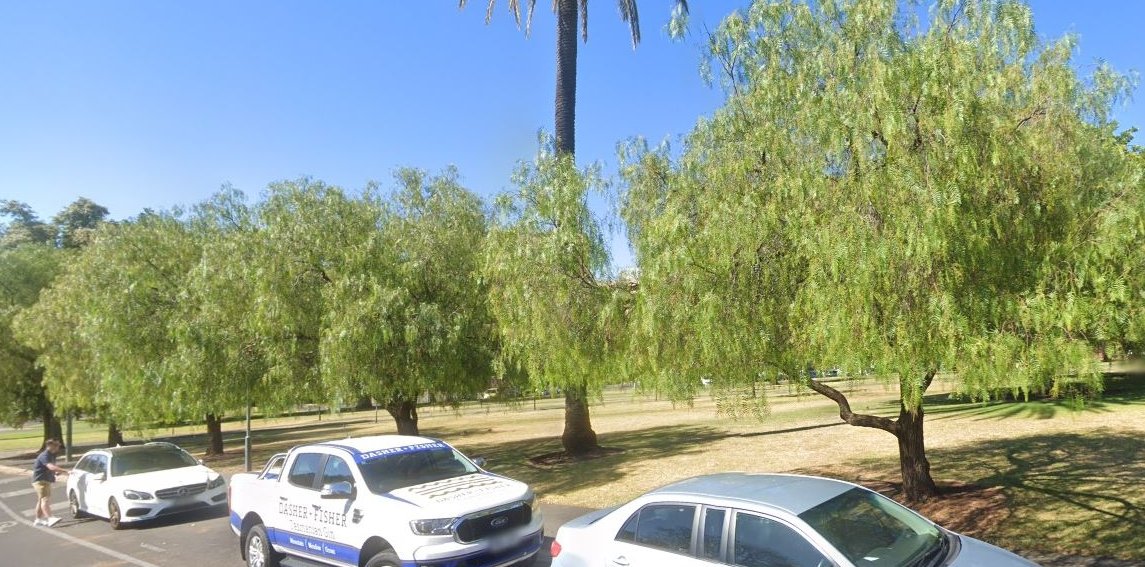by Natarsha McPherson
Among the wide assortment of native vegetation growing across your Adelaide Park Lands, there are also many non-native species.
One of the most common, found in multiple Parks, is the pepper tree, also known as the Peruvian peppertree (Schinus molle).
It’s found in Possum Park / Pirltawardli (Park 1), King Rodney Park / Ityamai-itpina (Park 15), Blue Gum Park / Kurangga (Park 20), Ellis Park / Tampawardli (Park 24), and Brougham Gardens / Tanutitingga (Park 29), among many other spots as well.
A line of pepper trees along the eastern edge of Brougham Gardens / Tantutitingga (Park 29). Image: Google Streetview.
With origins in South America, the large evergreen tree is an introduced species that towers over its surrounding habitat, at heights up to 15 metres.
Established among native species of similar stature, the peppertree is long-lived and drought-tolerant, which enables the tree to effectively endure and spread across Australia’s harsh climate.
A pepper tree in the BMX bike park within Blue Gum Park / Kurangga (Park 20).
Since introduction, the species has dispersed as an ornamental tree, establishing in a range of habitats, including open woodlands, grasslands, and even some coastal environments.
Leaves of the tree are pinnately compound – where divided leaflets are connected along both sides of the leaf stalk.
Comprising anywhere between 19 and 41 of these alternate leaflets, the tree’s leaves are generally 8-15cm in length and 4-9cm in width.
Here’s an avenue of pepper trees in King Rodney Park / Ityamai-itpina (Park 15). Often the branches will be hanging, giving the tree a drooping appearance, which is visually distinct from surrounding vegetation.
Along the tree’s drooping branches, clusters of small, white flowers may be identified. However, features that best allow identification of the species reside in the distinction of bright pink fruits that are sometimes referred to as ‘pink peppercorns’.
As a dioecious tree, female and male flowers occur on separate trees. Image: Bigpete on iNaturalist.
These fruits are small (5-7mm in diameter) and round, with colours ranging from green to red/pink, depending on their maturity.
Generally seen all year round, the berries are also situated in dense clusters, which greatly support reproduction and identification.
A pepper tree trunk located in Ellis Park / Tampawardli (Park 24). Parts of the tree, such as the leaves and bark, are considered aromatic when crushed.
For reproduction, the peppertree relies on seed dispersal from birds and other animals. These seeds can be found enclosed within the developed fruit, where their small and woody attributes provide protection against harsh environmental conditions and disturbance during dispersal.
After consumption, the seeds are transported across the landscape where they can establish in a range of habitats.
Although the tree can provide adequate shade and habitat for small insects and birds, it is generally regarded as an environmental weed across most of Australia.
Massive pepper trees off James Congdon Drive in Gladys Elphick Park / Narnungga (Park 25).
Want to know more about the plants in your Park Lands? Head over to iNaturalist, where you can record, share, and discuss your findings with fellow naturalists.
See the other plants featured in this series here: https://www.adelaide-parklands.asn.au/know-your-park-lands-plants.
Unless otherwise indicated, images on this page are from our Adelaide Park Lands photo albums.









